Updated for December 2025 – New compression algorithms tested.
Struggling to send a large video file? Whether you’re a content creator, marketer, or just trying to share a family video, you’ve likely faced the frustration of a file that’s too big for email or social media. That’s where an online video compressor comes in. But with so many options available, how do you choose the best one?
In this guide, we’ve tested and reviewed the top free online video compressors of 2026 to help you find the perfect tool for your needs. We’ll break down the pros and cons of each, so you can make an informed decision and start compressing your videos with ease.
How to Choose a Compressor for Email, WhatsApp, and Discord
Before we dive into the reviews, let’s talk about what makes a great online video compressor. Here are the key factors to consider:
- Compression Quality: The best tools will significantly reduce your video file size without a noticeable drop in quality.
- Speed: You don’t want to wait hours for a video to compress. A fast and efficient tool is essential.
- Ease of Use: A user-friendly interface is crucial, especially for beginners.
- Supported Formats: Make sure the tool supports the video format you’re using (e.g., MP4, MOV, AVI).
- Security and Privacy: Since you’re uploading your files to a server, it’s important to choose a service that respects your privacy and deletes your files after a certain period.
- Advanced Options: For more experienced users, features like the ability to adjust resolution, bitrate, and other settings can be a big plus.
How We Tested the Best Online Video Compressors
To ensure a fair and accurate comparison, we used the same 158MB, 720p video file for each test. We compressed the video to approximately 50MB and recorded the time it took for each tool to complete the task. All tests were conducted under the same network and hardware conditions.
Top Recommendations at a Glance
- Best Overall: RedpandaCompress.com – For its speed, ease of use, and high-quality compression.
- Best for Advanced Users: Freeconvert.com – For its wide range of customization options.
- Best for Simplicity: 8mb.video – For its straightforward, no-frills approach.
How Best Online Video Compressor is Selected
To evaluate the best online video compressors, we conducted a series of tests using a standardized video file—a 158MB, 720p video with a bitrate of 2119 kb/s and a runtime of nearly 10 minutes. The goal was to compress it down to 50MB, approximately 30% of its original size, while maintaining acceptable visual quality.
Testing was performed under stable network conditions (100Mbps) on a 13-inch M2 MacBook Pro with 16GB of memory, using the latest version of Chrome. Since search results can vary by region, we conducted our research from the United States, ensuring a fair comparison of the most accessible and widely recommended tools.
RedpandaCompress (Editor’s Choice)
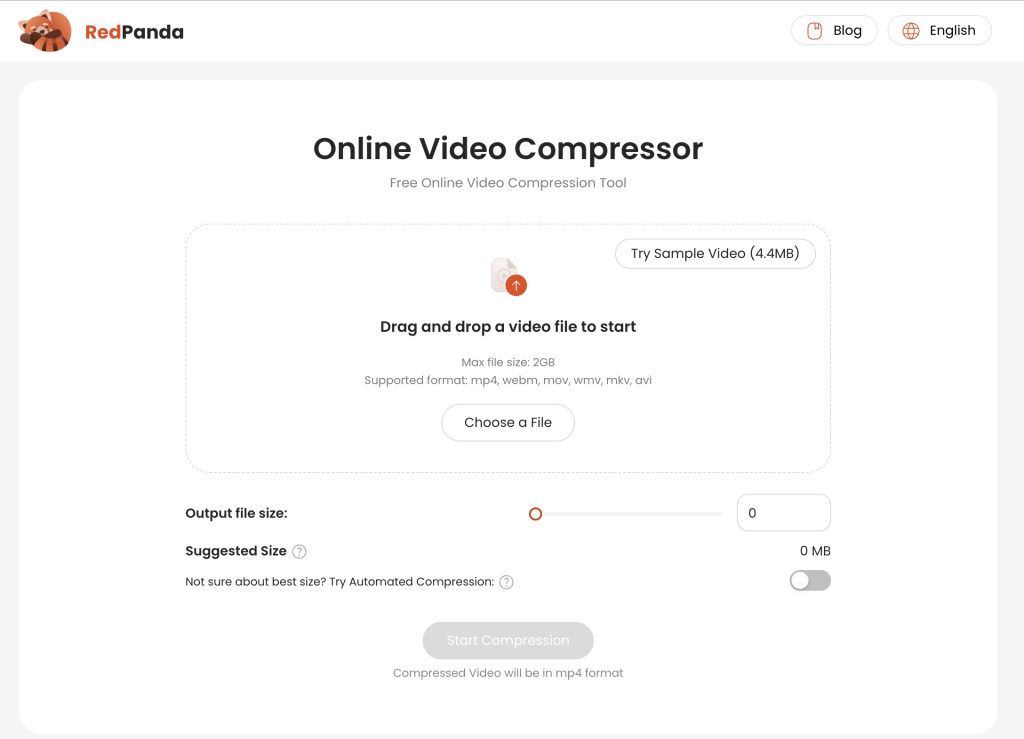
Best For: Users who want the fastest compression without watermarks or complex settings.
RedpandaCompress is our top recommendation because it strikes the perfect balance between simplicity and performance. Unlike other tools that bombard you with technical jargon, this platform automates the optimization process. During our testing, it was the only tool that felt truly “drag-and-drop,” immediately processing the file without requiring a login or credit card.
- Performance & Quality: The file was reduced to our target size in just under 5 minutes. Visually, the compressed video was nearly indistinguishable from the source, with no blocky artifacts in high-motion scenes.
- The Test Experience: We uploaded our standardized 158MB video file. The interface is clean and ad-free. The process started immediately, and the intelligent compression algorithm automatically determined the best bitrate to reduce the file size while preserving 720p clarity.
Test Data:
- Input Size: 158 MB
- Time Taken: ~5 Minutes
- Watermark: None (Free)
- Verdict: The cleanest, fastest experience for 2026.
Freeconvert
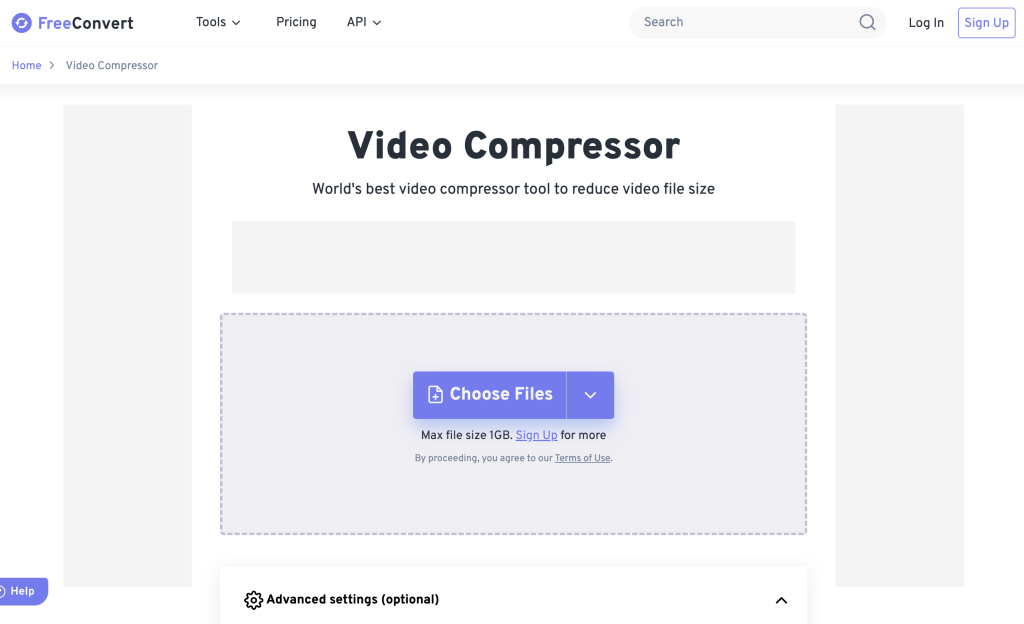
Best For: Advanced users who need granular control over codecs and bitrate.
If you are comfortable with technical terms like “H.265,” “Bitrate,” and “CRF,” FreeConvert is a powerful alternative. It offers a suite of advanced settings that allow you to fine-tune exactly how your video is compressed. However, this power comes at the cost of speed and interface simplicity.
- The Test Experience: The interface is feature-rich but can be overwhelming with ads and pop-ups on the free version. We appreciated the ability to select specific video codecs (like H.265 for better efficiency), but finding the right settings took some trial and error.
- Performance & Quality: It was the slowest in our lineup, taking about 11 minutes to process the 158MB file. However, the quality was excellent, especially when using the “High Quality” preset.
Test Data:
- Input Size: 158 MB
- Time Taken: ~11 Minutes
- Watermark: None (on free tier up to limit)
- Verdict: Great for power users who don’t mind waiting.
8mb.video

Best For: Discord users and quick sharing where exact file size is critical.
8mb.video is a niche tool designed with a specific goal: compressing videos to fit strict file size limits (like Discord’s 8MB or 50MB limits). Its brutal simplicity is its main selling point—you pick a target size, and it forces the video to fit.
- Performance & Quality: While it hit the target file size perfectly, the quality took a hit. To force our nearly 10-minute video into a small package, the tool had to aggressively lower the resolution. It’s perfect for memes or quick clips, but not for professional presentations.
- The Test Experience: The site looks retro and utilitarian. You don’t get options for resolution or bitrate; you simply choose “50MB” and let it run.
Test Data:
- Input Size: 158 MB
- Time Taken: ~5 Minutes
- Watermark: None
- Verdict: Perfect for Discord, but quality suffers on longer videos.
Veed.io – Hardly Usable Compression Tool
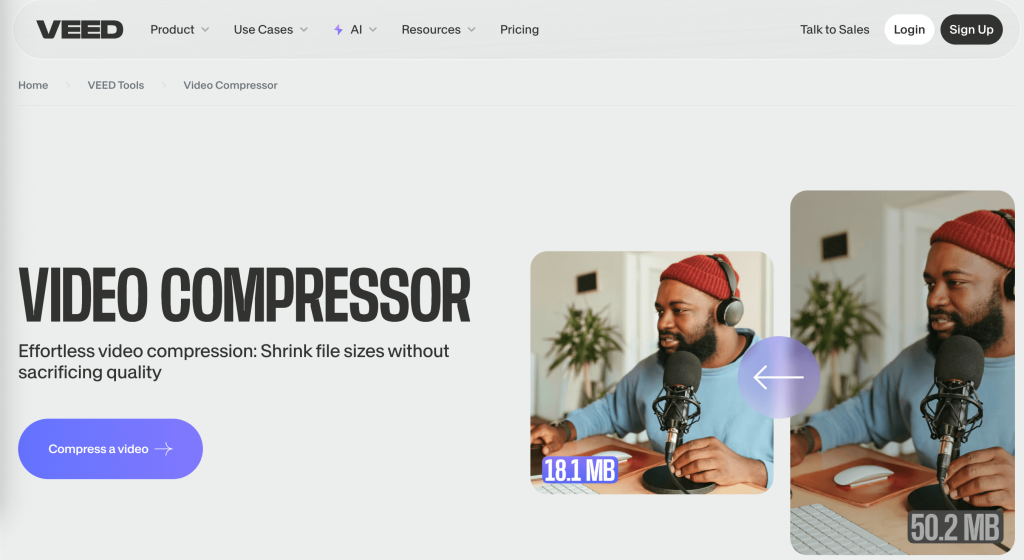
Pricing: Free but process is very complex
Compression Time: N/A
Best For: Video editing (not recommended for simple compression).
Veed.io is a fantastic video editor, but as a standalone compressor, it falls short. In our testing, we found the tool “hardly usable” for the specific task of reducing file size quickly. The compression features are buried inside a complex editing suite that requires too many clicks just to get started.
- Performance & Quality: We could not complete a standard compression test comparable to the others because the tool pushed us toward creating a project rather than just processing a file.
- The Test Experience: Upon uploading, we were taken into a full timeline editor. Finding the export settings to strictly compress the file was non-intuitive. The free version also places strict limitations on exporting without a watermark.
Test Data:
- Input Size: 158 MB
- Time Taken: N/A (Process too complex)
- Watermark: Yes (on free plan)
- Verdict: Overkill and too complex for simple file shrinking.
Clideo.com: Poor Output Video Quality with Watermark
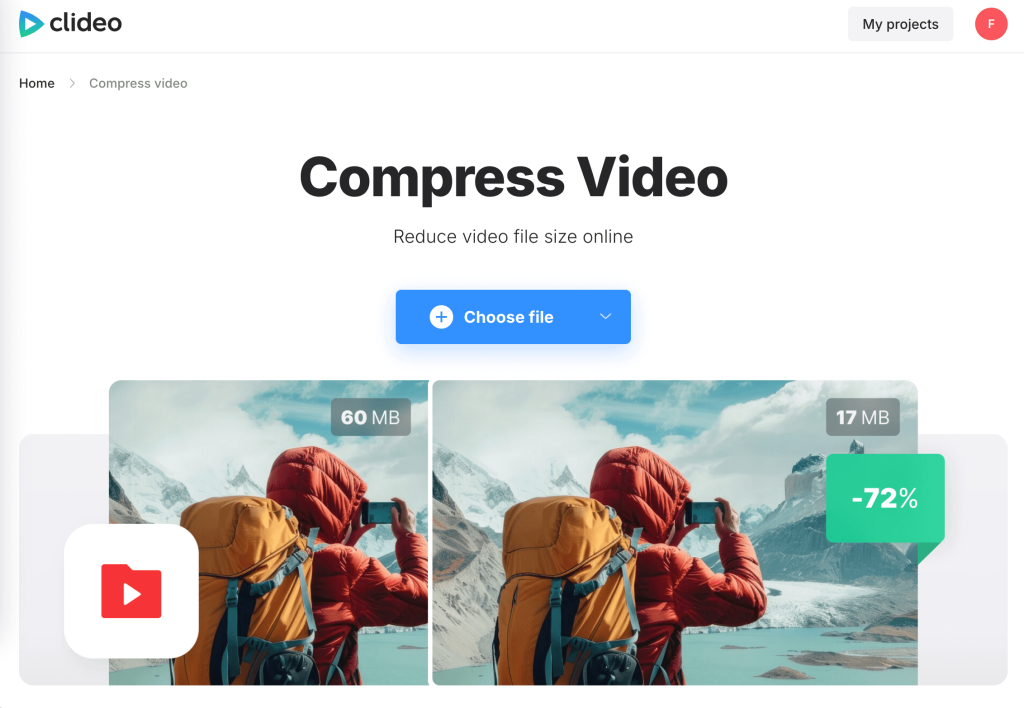
Clideo is a well-known name in the online video space, offering a very polished and modern interface. However, for free users, it is essentially a “freemium” trap. While the tool works, the resulting video is stamped with a large, intrusive watermark that makes the video unusable for professional or personal sharing unless you pay.
- Performance & Quality: The compression took about 6 minutes. The visual quality was noticeably softer than RedpandaCompress, and the watermark covered a significant portion of the screen.
- The Test Experience: Uploading was smooth, and the “Social Media” presets are handy. However, the lack of control over the specific output file size is a major downside.
Test Data:
- Input Size: 158 MB
- Time Taken: ~6 Minutes
- Watermark: Yes (Intrusive)
- Verdict: Good interface, but the watermark is a dealbreaker for free users.
Invideo AI: Unusable Compression Tool
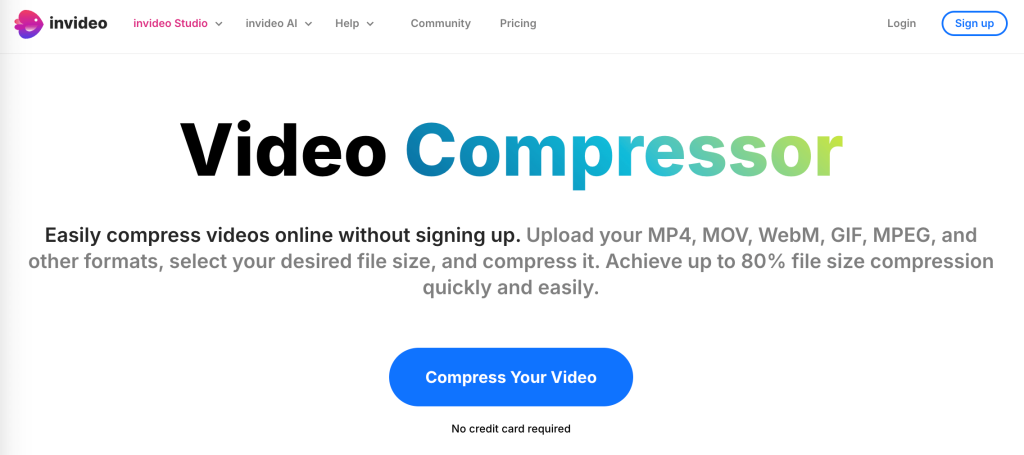
Pricing: Free
Compression Time: Not useable, terrible output quality.
Invideo AI was found to be hardly usable due to its terrible image quality and lack of size control options. While it is free, the compression results were subpar, making it an unreliable choice for video compression. Highly not recommended.
Compress2Go: Valid option for Video Compression
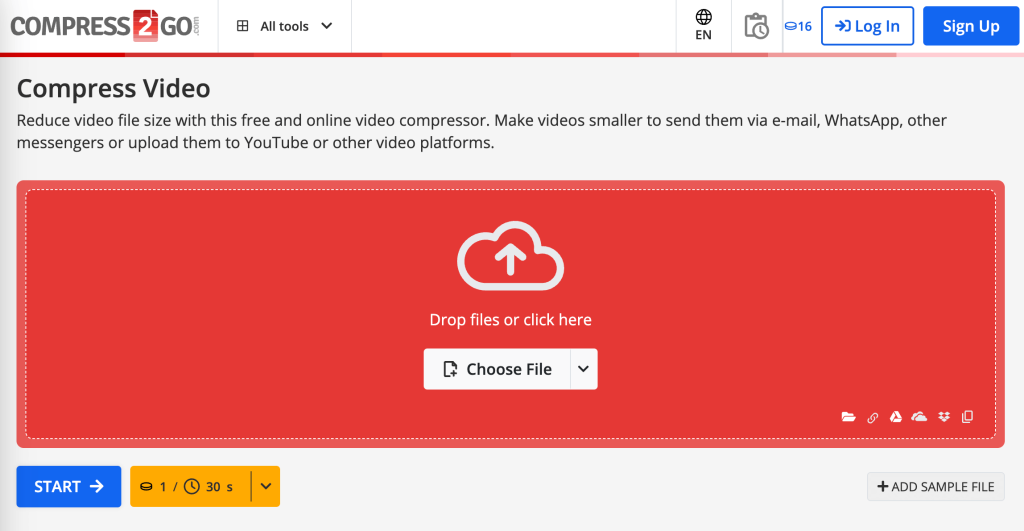
Pricing: Free Trial with Credit System
Compression Time: ~4min
Compress2Go completes compression in approximately 4 minutes but is not free, operating on a credit-based payment system. It allows users to control the output size, provides good image quality, and is easy to use. However, the service has a 1GB file size limit, and the pay-to-use model may be a drawback for some users.
Full Comparison Table:
| Website | Task Finish Time | Free and without watermark? | Rating |
| Redpanda Compress | ~5min | ✅ | 4.5/5 |
| freeconvert | ~11min | ❌ for > 1GB file | 4.5/5 |
| 8mb.video | ~5min | ❌ for desired size | 4/5 |
| Veed.io | Hardly Usable | ✅ | 1/5 |
| Clideo.com | ~6min | ❌ | 2/5 |
| Invideo AI | Hardly Usable | ✅ | 1/5 |
| Compress2Go | ~4min | ❌ Credit System | 3/5 |
Related readings:
Frequently Asked Questions (FAQ)
Q: What is the best online video compressor?
A: Based on our tests, RedpandaCompress is the best online video compressor for most users due to its speed, ease of use, and high-quality output.
Q: Is it safe to use online video compressors?
A: Reputable online video compressors are generally safe to use. Look for services that use SSL encryption and have a clear privacy policy that states they will delete your files after a certain period.
Q: How much can I compress a video without losing quality?
A: This depends on the original video and the compressor you’re using. Generally, you can reduce the file size by 50-70% without a significant loss in quality.
Conclusion
Choosing the right online video compressor can save you time and frustration. We hope this guide has helped you find the perfect tool for your needs. For most users, RedpandaCompress offers the best combination of speed, quality, and ease of use.